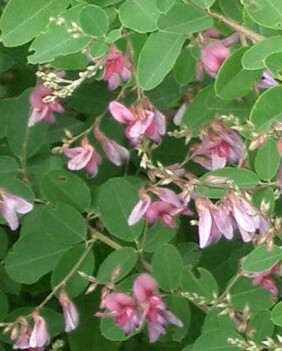 Bush clover is a loose deciduous medium sized shrub native to eastern Asia but introduced into the United States in the mid 1800’s as an ornamental. Later used for erosion control, revegetation of strip mined lands, and the improvement of wildlife habitats, it escaped cultivation and now has become invasive in parts of the Southeast. As an ornamental, bush clover offers dark green trifoliate leaves on gray to green stems and long arching sprays of five to fifteen small magenta-purple pea flowers. Bush clover is drought tolerant and grows well in infertile, medium dry well-drained soil and full sun to part shade, so is a good choice for difficult sites. Its roots fix nitrogen. In harsh climates it can be cut to the ground in late winter or early spring and will regrow to five feet tall in a single season. Two cultivars are available that are smaller and less invasive than the species.
Bush clover is a loose deciduous medium sized shrub native to eastern Asia but introduced into the United States in the mid 1800’s as an ornamental. Later used for erosion control, revegetation of strip mined lands, and the improvement of wildlife habitats, it escaped cultivation and now has become invasive in parts of the Southeast. As an ornamental, bush clover offers dark green trifoliate leaves on gray to green stems and long arching sprays of five to fifteen small magenta-purple pea flowers. Bush clover is drought tolerant and grows well in infertile, medium dry well-drained soil and full sun to part shade, so is a good choice for difficult sites. Its roots fix nitrogen. In harsh climates it can be cut to the ground in late winter or early spring and will regrow to five feet tall in a single season. Two cultivars are available that are smaller and less invasive than the species.
Type: Decidous flowering shrub
Outstanding Features: Late bloom
Form: Upright to cascading; open and loose
Growth Rate: Rapid
Bloom: Five to fifteen pea-like magenta purple flowers, half inch long, are produced in 2-5” long racemes on the upper 2’ of the stems in late summer.
Size: 5-10’ H x 5-10’ W
Light: Full sun to partial shade
Soil: Infertile, medium dry to moist, well-drained; drought tolerant
Hardiness: Zones 5-8 (roots to 4)
Care: Flowers are produced on new growth so prune in late winter to early spring. If top dies back in harsh winter cut to ground in late winter or early spring
Pests and Diseases: None of significance
Propagation: Seed,; half-ripe cuttings in July/August but difficult to over winter new plants.
Outstanding Selections:
 ‘Little Buddy’ (compact, 3’ tall, less aggressive than species, yellow leaves in fall)
‘Little Buddy’ (compact, 3’ tall, less aggressive than species, yellow leaves in fall) ‘Yakushima’( dwarf to 12-18” tall, smaller leaves, smaller flowers, less invasive than species).
‘Yakushima’( dwarf to 12-18” tall, smaller leaves, smaller flowers, less invasive than species).